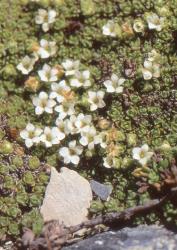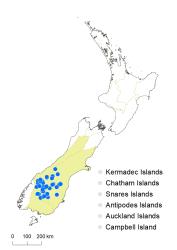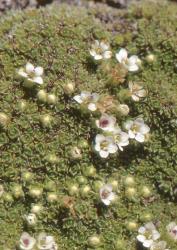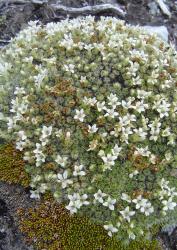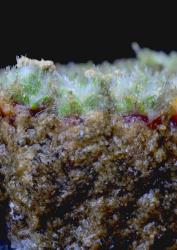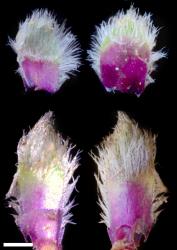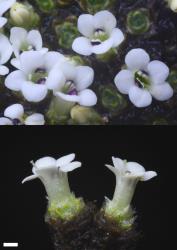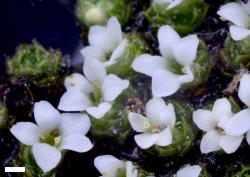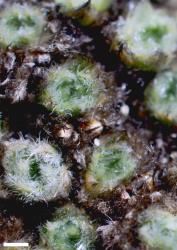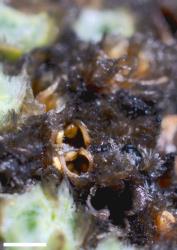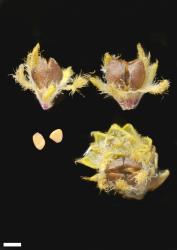- ≡ Pygmea thomsonii Buchanan, Trans. & Proc. New Zealand Inst. 14: 353, t. xxxii (1882) – as Pygmea thomsoni
- ≡ Chionohebe thomsonii (Buchanan) B.G.Briggs & Ehrend., Contr. Herb. Austral. 25: 2 (1976)
- = Pygmea myosotoides Ashwin in Allan, Fl. New Zealand 1, 873 (1961)
- ≡ Chionohebe myosotoides (Ashwin) B.G.Briggs & Ehrend., Contr. Herb. Austral. 25: 2 (1976)
- ≡ Veronica myosotoides (Ashwin) Garn.-Jones in Garnock-Jones et al., Taxon 56: 578 (2007)
Dense cushion plant 0.01–0.08 m tall. Stems erect, densely crowded, glabrous. Leaf bud indistinct, its outer leaves fully grown, diverging, sub-decussate, sub-erect to appressed; lamina thin, oblanceolate to obovate, 1.7–4.7 mm long, 0.7–2.6 mm wide, dull green to olive-green above and beneath in distal half, pale brown to purplish towards base; veins not evident; adaxial surface with stiff eglandular hairs in a dense band across middle and occasional scattered hairs distally; abaxial surface glabrous or with hairs on distal half; margin ciliate especially in basal ⅔ and usually in an apical tuft, entire; apex obtuse to sub-acute; base cuneate; petiole absent. Inflorescence a solitary axillary bibracteate flower; flowers female or male on separate plants, ♂ > ♀; bracts 2, opposite, narrowly elliptic to oblanceolate, overtopping and investing calyx; pedicel absent. Calyx lobes 5, equal, obtuse to sub-acute, 1.5–2.8 mm long, glabrous or sparsely eglandular near apex adaxially, sparsely to densely eglandular-hairy distally abaxially, glabrous towards base; margins ciliate, rarely glabrous near apex or base. Corolla 2.5–5.0 mm diameter; tube white, 2.0–3.5 mm long, ≥calyx, glabrous; lobes 5, rarely 6, white, erecto-patent to spreading, equal, narrowly ovate to broadly obovate, 1–2 mm long, obtuse; nectar guides absent. Stamen filaments white, 0.2–0.5 mm long; anthers magenta to purple, sometimes white or pink. Style glabrous, 2.8–4.6 mm long. Capsules angustiseptate, emarginate to obcordate, glabrous to densely hairy at apex, 1.5–3.0 mm long, 1–2 mm at widest point. Seeds discoid to ellipsoid, weakly flattened, smooth, orange-brown to brown, 0.6–0.8 mm long.
birleyi | spectabilis | trifida | densifolia | thomsonii | pulvinaris | chionohebe | ciliolata | |
|---|---|---|---|---|---|---|---|---|
Habit | lax sub-shrub | lax sub-shrub | lax sub-shrub | lax sub-shrub | cushion plant | cushion plant | cushion plant | cushion plant |
Stem hairs | eglandular & a few glandular, spreading | mixed glandular & eglandular, spreading | eglandular, retrorse | eglandular, retrorse | glabrous | glabrous | glabrous | glabrous |
Leaf size (mm) | 4.0–12 × 2.5–11 | 4.5–13 × 2.5–6.0 | 2–10 × 1–7 | 2–6.5 × 0.7–3 | 1.7–4.7 × 0.7–2.6 | 1.8–4.8 × 0.5–2 | 1.75–5 × 0.75–2.25 | 1.75–4.5 × 0.8–2.8 |
Leaf margins | deeply crenate to lobed | deeply crenate to lobed | shallowly toothed to lobed, rarely entire | usually entire, rarely 1–2 teeth or lobes | entire | entire | entire | entire |
Lamina | subcoriaceous, flat; margin not thickened, smooth | subcoriaceous, flat; margin not thickened, smooth | subcoriaceous, flat; margin not thickened, smooth | coriaceous, keeled, with thickened papillate margin | thin, flat; margin not thickened, smooth | thin, flat; margin not thickened, smooth | thin, flat; margin not thickened, smooth | thin, flat; margin not thickened, smooth |
Leaf hairs: adaxial | scattered eglandular | mixed eglandular & glandular | glabrous | glabrous | eglandular: in broad band across middle, occasionally scattered distally | eglandular appressed: scattered or in a central patch on distal half | absent | absent or isolated and scattered in distal ½ |
Leaf hairs: abaxial | scattered eglandular | mixed eglandular & glandular | glabrous | glabrous | glabrous, or stiff, eglandular, isolated distal hairs | glabrous or eglandular appressed scattered distally | absent or isolated in distal ½ | absent or isolated and scattered in distal ½ |
Leaf hairs: margin | eglandular-ciliate | mixed eglandular & glandular-ciliate | long glandular-ciliate | stiff eglandular-ciliate | ciliate in basal ⅔ with apical tuft | eglandular appressed: ciliate | absent or scattered cilia | ciliate throughout or in basal or distal half, usually with apical tuft |
Sexual system | cosexual | cosexual | cosexual | cosexual | dioecious | dioecious | dioecious | dioecious |
Inflorescence | 2–3 flowers, sometimes solitary bibracteolate | 2–3 flowers, sometimes solitary bibracteolate | 2–3 flowers, sometimes solitary bibracteolate | solitary bibracteolate | solitary bibracteolate | solitary bibracteolate | solitary bibracteolate | solitary bibracteolate |
Peduncle (mm) | 2–4 | 5–15 | 2–10 | 0 | 0 | 0 | 0 | 0 |
Pedicel (mm) | 0.3–1.5 | 2.5–5 | 0.5–7 | 0 | 0 | 0 | 0 | 0 |
Calyx lobes | 4 | 4 | 4 | 5 | 5 | 5 | 5 | 5 |
Corolla lobes | (4–)5(–6) | 4(–5) | 5(–6) | 5(–6) | 5 | 5 | 5 | 5 |
Corolla diameter (mm) | 7–10 | 18–25 | 15–20 | 7–16 | 2.5–5 | 2.5–6 | 1.5–4.1 | 2.1–6.5 |
Corolla shape | funnelform | funnelform | funnelform | funnelform | rotate | rotate | rotate | rotate |
Capsule size (mm) | 3–4 × 3–4 | 4–5 × 4–5 | 4.5–6 × 2.5–3 | 2.7–5 × 1.7–4.25 | 1.5–3 × 1–2 | 1–3 × 1.2–2.7 | 1.9–2.5 × 1.5–1.9 | 2.5–3.5 × 1.4–3.1 |
Capsule hairs | glabrous | mixed glandular & eglandular-hairy at apex | glandular-ciliate, sometimes glabrous | glabrous | glabrous to densely hairy at apex | eglandular-hairy, especially at apex | absent | absent or apical |
South Island: south Westland, South Canterbury, Otago (on and west of the Rock and Pillar Range), Southland (Eyre Mountains). A specimen in CHR labeled Mt Captain (North Canterbury) has not been included on the map.
Alpine to high alpine herb-field, fell-field, and cushion-field, among rocks, in crevices, on rocky outcrops, stony soil, rock tors and exposed ridges. Recorded elevations range from 1219 to 2086 m.
Veronica ×uniflora Kirk, Transactions of the New Zealand Institute 28: 522 (1896, as V. uniflora), ≡ Hebe uniflora (Kirk) Cockayne & Allan, Transactions of the New Zealand Institute 57: 43 (1926). ≡ Logania armstrongii Buchanan, Transactions of the New Zealand Institute 14: 347, t. 28, f. 3 (1882) non Veronica armstrongii J.B.Armstr., New Zealand Country Journal 3: 59 (1879). ≡ Pygmea armstrongii Ashwin in Allan, Flora of New Zealand 1: 875 (1961). Lectotype: WELT SP086066 (Garnock-Jones 2008). The distributions of V. thomsonii and V. densifolia overlap widely in Otago, and hybrids have been collected from seven locations (Hector Col, Matukituki River valley; Richardson Mountains; Mt Pisa; Garvie Mountains; Hector Mountains; Dunstan Range; Old Man Range). The plants resemble small forms of V. densifolia but have smaller leaves in a slightly sub-decussate and more appressed arrangement, a distinctive patch of stiff hairs on the adaxial surface, longer cilia on the leaf margins, and smaller flowers (Meudt 2008).
Where V. thomsonii abuts the ranges of V. ciliolata in the west and V. pulvinaris in the north, intermediate plants may be found, suggestive of some gene exchange between these species (Meudt 2008).
V. chionohebe × thomsonii. V. chionohebe, and V. thomsonii grow together in the Garvie Mountains and Pisa Range, and it is possible that hybridisation occurs between them. This might be the reason that molecular systematics techniques have so far not provided evidence of genetic divergence between them, despite morphological and habitat differences (Meudt 2008; Meudt & Bayly 2008).
Flowers: January–March; sometimes December; fruits: March.
2n = 42 (Hair 1970, as Pygmea thomsonii).
Veronica thomsonii is classified in V. subg. Pseudoveronica sect. Hebe and informally in the “snow hebe” group (Albach & Meudt 2010).
Flowers on male plants are larger and have obvious and usually coloured anthers at the throat of the corolla; flowers on female plants are smaller, and their anthers are sterile, small and pale.



